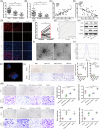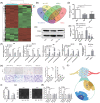Loss of exosomal miR-26a-5p contributes to endometrial cancer lymphangiogenesis and lymphatic metastasis
- PMID: 35538902
- PMCID: PMC9092006
- DOI: 10.1002/ctm2.846
Loss of exosomal miR-26a-5p contributes to endometrial cancer lymphangiogenesis and lymphatic metastasis
Conflict of interest statement
The authors declare that no conflict of interests.
Figures




Similar articles
-
Identification of microRNAs associated with lymphangiogenesis in human gastric cancer.Clin Transl Oncol. 2014 Apr;16(4):374-9. doi: 10.1007/s12094-013-1081-6. Epub 2013 Jul 24. Clin Transl Oncol. 2014. PMID: 23881463
-
Exosomal lncRNA NEAT1 from cancer-associated fibroblasts facilitates endometrial cancer progression via miR-26a/b-5p-mediated STAT3/YKL-40 signaling pathway.Neoplasia. 2021 Jul;23(7):692-703. doi: 10.1016/j.neo.2021.05.004. Epub 2021 Jun 18. Neoplasia. 2021. PMID: 34153644 Free PMC article.
-
MicroRNA-129-5p suppresses nasopharyngeal carcinoma lymphangiogenesis and lymph node metastasis by targeting ZIC2.Cell Oncol (Dordr). 2020 Apr;43(2):249-261. doi: 10.1007/s13402-019-00485-5. Epub 2019 Dec 28. Cell Oncol (Dordr). 2020. PMID: 31884576
-
Lymphangiogenesis, lymphatic systemomics, and cancer: context, advances and unanswered questions.Clin Exp Metastasis. 2018 Aug;35(5-6):419-424. doi: 10.1007/s10585-018-9907-9. Epub 2018 May 28. Clin Exp Metastasis. 2018. PMID: 29808352 Review.
-
NRP-2 in tumor lymphangiogenesis and lymphatic metastasis.Cancer Lett. 2018 Apr 1;418:176-184. doi: 10.1016/j.canlet.2018.01.040. Epub 2018 Jan 12. Cancer Lett. 2018. PMID: 29339213 Review.
Cited by
-
New insights for gynecological cancer therapies: from molecular mechanisms and clinical evidence to future directions.Cancer Metastasis Rev. 2023 Sep;42(3):891-925. doi: 10.1007/s10555-023-10113-2. Epub 2023 Jun 27. Cancer Metastasis Rev. 2023. PMID: 37368179 Free PMC article. Review.
-
Tumor suppressor genes are reactivated by miR-26A1 via enhancer reprogramming in NSCLC.Hum Mol Genet. 2023 Jan 1;32(1):79-92. doi: 10.1093/hmg/ddac185. Hum Mol Genet. 2023. PMID: 35921230 Free PMC article.
-
The role of ncRNAs and exosomes in the development and progression of endometrial cancer.Front Oncol. 2024 Aug 12;14:1418005. doi: 10.3389/fonc.2024.1418005. eCollection 2024. Front Oncol. 2024. PMID: 39188680 Free PMC article. Review.
-
The Role and Applications of Exosomes in Gynecological Cancer: A Review.Cell Transplant. 2023 Jan-Dec;32:9636897231195240. doi: 10.1177/09636897231195240. Cell Transplant. 2023. PMID: 37632354 Free PMC article. Review.
-
Advances in peptides encoded by non-coding RNAs: A cargo in exosome.Front Oncol. 2022 Dec 23;12:1081997. doi: 10.3389/fonc.2022.1081997. eCollection 2022. Front Oncol. 2022. PMID: 36620552 Free PMC article. Review.
References
-
- Siegel RL, Miller KD, Fuchs HE, et al. Cancer statistics, 2022. CA Cancer J Clin. 2022;72(1):7‐33. - PubMed
-
- Alitalo K, Tammela T, Petrova TV. Lymphangiogenesis in development and human disease. Nature. 2005;438(7070):946‐953. - PubMed
-
- Achen MG, McColl BK, Stacker SA. Focus on lymphangiogenesis in tumor metastasis. Cancer Cell. 2005;7(2):121‐127. - PubMed
-
- Nedaeinia R, Manian M, Jazayeri MH, et al. Circulating exosomes and exosomal microRNAs as biomarkers in gastrointestinal cancer. Cancer Gene Ther. 2017;24(2):48‐56. - PubMed
Publication types
MeSH terms
Substances
LinkOut - more resources
Full Text Sources
